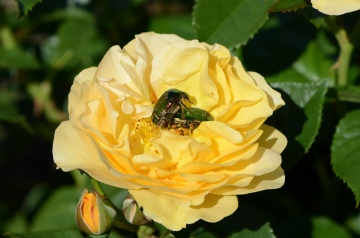Species Account for Cetonia aurata
PLEASE NOTE, many records in this group are not yet available
Cetonia aurata (Linnaeus, 1761)
Rose Beetle
Coleoptera: Scarabaeidae

Reproduction for study and non-profit use permitted, all other rights reserved.
Taxonomic group: beetles (Coleoptera) - Available county data
View time series maps for Cetonia aurata
member log-on for taxon report
Images
upload a new image
Species text
Modern records for the Rose Chafer are centred around the Colchester area in the north-east of the county and a small part of the Lee and Roding Valley areas in south-west Essex, as well as a seemingly well-established population in a compost heap in Witham.
Peter Hammond (pers.comm.) writes that older Essex data includes a few very old records for the Colchester and Epping areas, some not quite so old but pre-1950 records for Waltham Abbey, Buckhurst Hill, Lexden and Thorpe-le-Soken. Most of these records are for 1946, a particularly ‘good’ Cetonia year. He also has a series of his own records for the Chelmsford area (Broomfield, Chelmsford, Gt Baddow) for the years 1953, 1957, 1958, 1959 and 1963, and there are one or two extra Epping Forest records noted in Buck’s (1955) paper. The very last of the Chelmsford area records was one by Cliff Barham who found one on a pavement in Chelmsford town centre on 9 April 1963.
It seems that a century ago the Rose Chafer was considered to be generally distributed and common in the south of the country, becoming scarcer and more local in the Midlands, and distinctly rarer north of this. In Suffolk the Rose Chafer has always been rare and very localised, and has apparently not been recorded since April 1961 (Nash, 2007 in White Admiral 66). Interestingly, it seems as though the situation has been much the same in Norfolk as it has in Suffolk and Essex. There are a couple of late 19th century Norfolk records (Norwich and Downham Market), and Peter Hammond has been informed by Martin Collier that he has only a couple of later ones for the county, for individuals found at Thorpe (Norwich outskirts) in August 1961 and July 1962. The lack of subsequent Norwich records seems to very much mirror the Suffolk and Essex experience, i.e. a cut off after 1963! References
Habitats
Why not join the Club, register and add a new species page
Interpretation of distribution maps
























